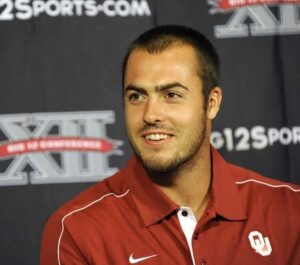
I recently came across a post from our buddy Dave Bartoo at cfbmatrix.com about drafting quarterbacks that might raise the interest of Sooner fans.
With the NFL draft quickly approaching, Bartoo found an intriguing relationship between his “Coaching Effect” statistic and quarterback play in the NFL. (A team’s Coaching Effect reflects the difference between the number of games it wins and the numbers of games that it should win based on talent and schedule – positive means the team won more games than it should, negative means fewer.)
Essentially, using data dating back to 2004, he found that quarterbacks who played for programs with a negative Coaching Effect tend to crap out in the pros at a disproportionately high rate (80 percent versus an average miss rate of 66 percent, based on Bartoo’s subjective analysis of QB busts). To illustrate the relationship, consider Charlie Weis, owner of a decidedly negative Coaching Effect score. Despite learning at the hand of the man who purportedly molded Tom Brady into one of the best NFL QBs ever, Weis’ two college protégés, Brady Quinn and Jimmy Clausen, have flamed out in the big leagues.
In this year’s crop of matriculating college quarterbacks, Bartoo’s “formula,” for lack of a better word, indicates that NFL teams should avoid selecting guys like Matt Barkley and Geno Smith. On the other hand, Ryan Nassib and Matt Scott make better bets.
Clearly, this is far from some kind of failsafe approach to drafting quarterbacks. If QBs start with a two-in-three chance of washing out, it goes to show just how much of a crapshoot drafting a QB is.
For our purposes, though, does this tell us anything about quarterbacking at the collegiate level?
Given this trend, I asked Bartoo if it’s possible that what he terms Coaching Effect is actually a “Quarterback Effect.” In other words, when a team outperforms its talent, is that more likely a product of having a plus QB than a great coach? He told me that the body of evidence suggests that some coaches remain elite no matter who is taking snaps – Bill Snyder is an example. In other cases, it’s the elite quarterbacks who have shown the ability to elevate mediocre coaches, such as Aaron Rodgers and Jeff Tedford at California.
(I realize that the idea that a good quarterback can make a bad coach look better sounds intuitive, but it’s interesting to me to test out these assumptions.)
So, what about Landry Jones, Oklahoma’s four-year starter? OU had a negative Coaching Effect score (-1) in both 2011 and 2012. That led Bartoo to conclude that the ‘Stache is in the group that has a four-in-five chance of busting.
Best of luck to Jones in the NFL. This raises an interesting possibility to me, though. Prior to Jones taking over at quarterback, Oklahoma’s Coaching Effect under Bob Stoops fell on the positive side of the ledger. At the very least, his teams performed up to expectations relative to their levels of talent.
Personally, I think the weaknesses in OU’s program at the moment go beyond the quarterback position. I’m also not in any way trying to bag on Jones, who shouldered more than his fair share of the blame for the perceived shortcomings of the program during the last four years. However, seeing as someone new will trot out as the Sooners’ starting QB for the first time in four years, this at least adds a little more intrigue to the upcoming season for me.
